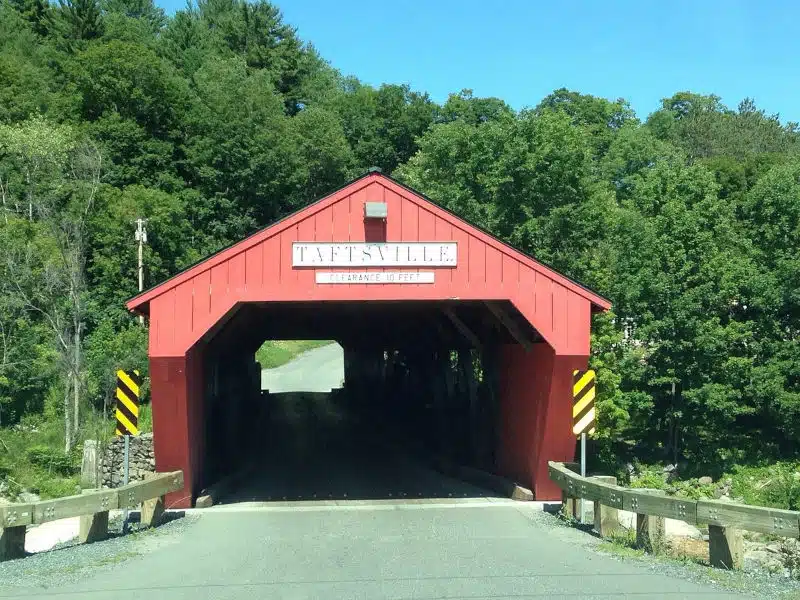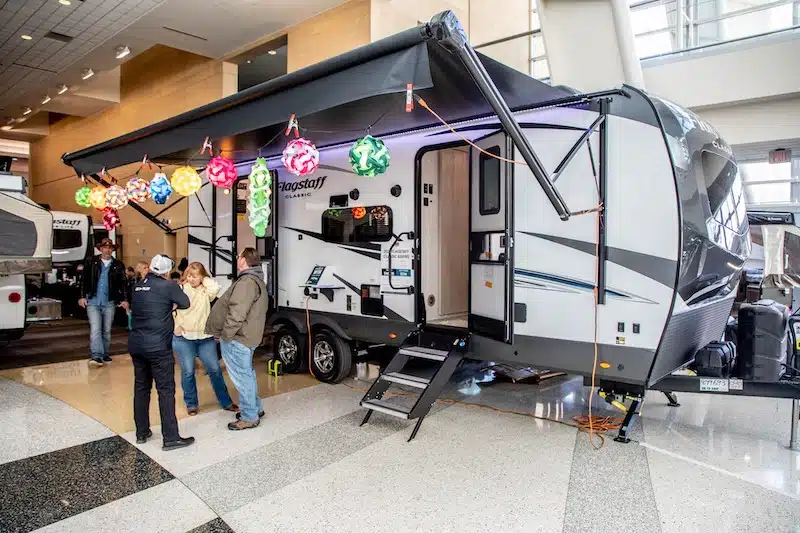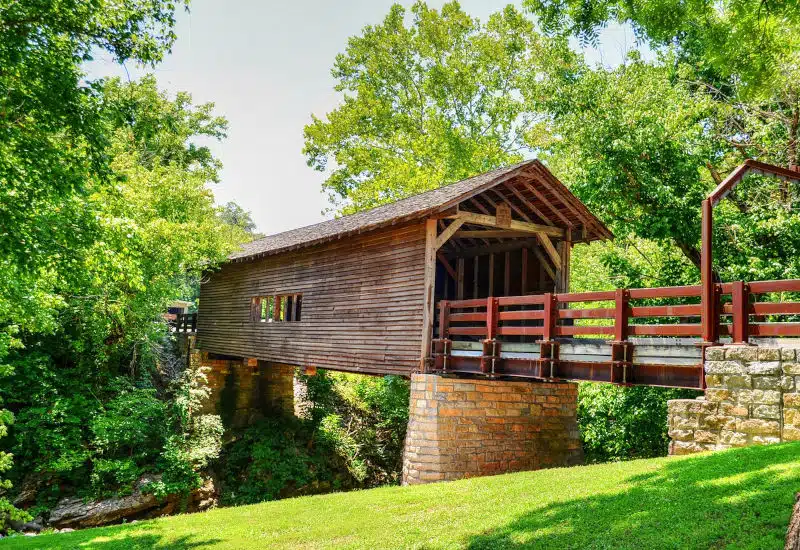The Northeastern United States, characterized by its picturesque landscapes and deep-rooted history, is home to a diverse collection of covered bridges. From the rural corners of Vermont to the bustling environments of New York, these structures stand as enchanting emblems of the region’s past and architectural legacy.
Vermont, often called the “Covered Bridge Capital of New England,” hosts a number of charming examples like the iconic Cornwall-Salisbury Covered Bridge near the town of Salisbury and the Scott Covered Bridge, the longest wooden bridge in the state, nestled near Townshend. New Hampshire, too, offers a wealth of these architectural treasures, including the Bath-Haverhill Covered Bridge near Woodsville, the oldest in the state, and the picturesque Blair Covered Bridge near Campton.
Further south, Pennsylvania boasts more covered bridges than any other state, with notable structures like the historic Sachs Covered Bridge near Gettysburg and the Knox Covered Bridge in Valley Forge. Whether you’re captivated by architectural history or simply love the romance and nostalgia associated with these structures, the Northeast’s covered bridges offer a journey into a bygone era of craftsmanship and community.
Enchanting Covered Bridges of the Northeast
The Northeast is home to some of the most enchanting covered bridges in the United States, from the historic passageways of Pennsylvania to the picturesque spans of Vermont and the scenic crossings of New Hampshire. As you explore these beautiful structures, you’ll be captivated by their charm, history, and the breathtaking landscapes that surround them.
So why not take a trip off the beaten path and discover the enchanting covered bridges of the Northeast?
- Explore the Most Beautiful Covered Bridges of the USA
- 30 Beautiful Covered Bridges in America’s Southern States
- 30 Amazing Covered Bridges in America’s Midwest
- 20 Historic Covered Bridges on America’s West Coast
Pennsylvania’s Historic Passageways
In Pennsylvania, the Great Allegheny Passage is a 150-mile non-motorized path that connects Pittsburgh to Cumberland, Maryland. This historic passageway is one of the most celebrated rail trails in the country and is home to several covered bridges, including the Blacksmith Shop Bridge in Cornish, the seven historic covered bridges in the Monadnock Region, and the Cornish-Windsor Bridge, the longest wooden covered bridge in the United States.
As you traverse this historic passage, take a moment to appreciate the history and beauty of these remarkable structures.
1. Schofield Ford Covered Bridge
- The Schofield Ford Covered Bridge is located in Bucks County, near the town of Newtown. Nestled within the Tyler State Park, it offers a serene setting amidst the landscapes of eastern Pennsylvania.
- This 170-foot bridge showcases a Town lattice truss design. Constructed from heavy timber and painted a rustic red hue, it stands out beautifully against its natural setting.
- The original bridge was built in 1873 but was destroyed by fire in 1991. It was later reconstructed using traditional methods and now stands as a testament to the area’s rich architectural heritage.
2. Pine Valley Covered Bridge
- Located in Bucks County, close to the town of New Britain, the Pine Valley Covered Bridge offers a picturesque view over Pine Run Creek.
- Spanning 81 feet, this bridge features a Burr arch truss design. Constructed primarily from wood and featuring a barn-red exterior, it presents a delightful sight against its pastoral backdrop.
- The bridge was constructed in 1842 and remains one of the few surviving examples of its design in Pennsylvania. It’s now part of the Pine Valley Covered Bridge Park, symbolizing the area’s rich architectural heritage.
3. Knecht’s Covered Bridge
- The Knecht’s Covered Bridge is situated in Bucks County, near the town of Springfield. Set amidst idyllic farmland, it offers a tranquil rural setting.
- Spanning 110 feet, this bridge showcases a Burr arch truss design. Constructed from heavy timber and painted a vibrant red, it provides a picturesque sight over Cooks Creek.
- Built in 1873, the bridge continues to serve as an essential passage for local transportation and stands as a cherished local landmark.
4. Uhlerstown Covered Bridge
- The Uhlerstown Covered Bridge is located in Bucks County, near the town of Uhlerstown. The bridge is nestled over the Delaware Canal, offering a scenic location amidst Pennsylvania’s rural landscapes.
- Spanning 101 feet, this bridge features a Burr arch truss design. Constructed primarily from wood and featuring a rustic red exterior, it offers a picturesque sight against its bucolic backdrop.
- Constructed in 1832, the bridge is the only covered bridge crossing the Delaware Canal. It stands as a testament to Pennsylvania’s rich architectural history.
5. South Perkasie Covered Bridge
- The South Perkasie Covered Bridge is situated in Bucks County, near the town of Perkasie. Set in the Lenape Park, it offers a peaceful retreat within the rustic landscapes of eastern Pennsylvania.
- Spanning 93 feet, this bridge showcases a Town lattice truss design. Built primarily from wood and featuring a rustic red exterior, it adds a charming accent to the surrounding park.
- Constructed in 1832, the bridge was later moved to the park in 1959 to preserve it from demolition. It stands as a historic icon, reflecting the rich heritage and rural charm of Pennsylvania.
6. Frankenfield Covered Bridge
- Frankenfield Covered Bridge is located in Bucks County, close to the town of Tinicum. Set amidst serene farmland, it offers a picturesque view over Tinicum Creek.
- Spanning 130 feet, this bridge features a Burr arch truss design. Constructed from heavy timber and painted a striking red hue, it presents a captivating sight against its rural backdrop.
- Built in 1872, the bridge serves as a vital link for local transportation. It remains a valued local landmark and a symbol of the region’s rural heritage.
7. Sheard’s Mill Covered Bridge
- Sheard’s Mill Covered Bridge is situated in Bucks County, near the town of Haycock. Overlooking the Tohickon Creek, it offers a tranquil setting.
- Spanning 130 feet, this bridge showcases a Burr arch truss design. Made from timber and featuring a barn-red exterior, it adds a beautiful contrast to the surrounding greenery.
- Built in 1835, the bridge served as an essential link for local transportation. Despite several renovations, it maintains its historical charm and continues to be a key landmark in the region.
8. Van Sant Covered Bridge
- Van Sant Covered Bridge is located in Bucks County, close to the town of New Hope. Nestled amidst the scenic landscapes of southeastern Pennsylvania, it offers a serene retreat.
- Spanning 86 feet, this bridge features a Town lattice truss design. Constructed from sturdy timber and featuring a vibrant red exterior, it provides a captivating sight over Pidcock Creek.
- Constructed in 1875, the bridge stands as a treasured local icon, symbolizing the rich heritage of Pennsylvania’s covered bridges.
9. Erwinna Covered Bridge
- Erwinna Covered Bridge is located in Bucks County, near the town of Tinicum. It offers a peaceful setting over the Lodi Creek.
- Spanning 56 feet, this bridge showcases a queen post truss design. Built from timber and painted a traditional red, it adds a beautiful accent to the surrounding rural beauty.
- Constructed in 1832, the bridge is one of the oldest in Bucks County. It stands as a historic icon, reflecting the rich heritage and rural charm of Pennsylvania.
10. Mood’s Covered Bridge
- Mood’s Covered Bridge is situated in Bucks County, close to the town of East Rockhill. Located over the East Branch Perkiomen Creek, it offers a tranquil retreat within the rustic landscapes of eastern Pennsylvania.
- Spanning 130 feet, this bridge showcases a Town lattice truss design. Built primarily from wood and featuring a rustic red exterior, it adds a charming accent to the surrounding rural beauty.
- Constructed in 1874, the original bridge was sadly destroyed by arson in 2004. However, a faithful replica was later built, preserving its historic charm and significance to the local community.
Vermont’s Picturesque Spans
Vermont, home to more than 100 covered bridges, is a treasure trove of picturesque spans. Among them is the Woodstock Middle Covered Bridge, which traverses the Ottaquechee River and is the focal bridge of Woodstock. Constructed in 1883, this historic bridge is one of the few extant covered bridges in Vermont and is included in the National Register of Historic Places.
When visiting Vermont, be sure to take the time to explore and photograph these charming covered bridges, as they offer a unique and unforgettable experience.
11. Cornish–Windsor Covered Bridge
- The Cornish–Windsor Covered Bridge spans the Connecticut River, connecting the towns of Cornish, New Hampshire, and Windsor, Vermont. It is one of the most significant landmarks in the region.
- This 449-foot-long bridge is one of the longest wooden covered bridges in the United States. It features a Town lattice truss design and is constructed from heavy timber with a traditional red exterior.
- Built in 1866, the bridge replaced a series of previous bridges that were destroyed by floods. It is listed on the National Register of Historic Places and is a stunning testament to 19th-century American engineering.
12. Middle Covered Bridge
- Middle Covered Bridge is located in the town of Woodstock, nestled over the Ottauquechee River. It is a centerpiece of one of the most picturesque towns in Vermont.
- The bridge spans 139 feet and showcases a Town lattice truss design. Made from heavy timber and painted a charming white, it offers a delightful sight against its beautiful surroundings.
- Constructed in 1969 as a replacement for an earlier bridge, it has become a cherished landmark in Woodstock, symbolizing the rich heritage and charm of the town.
13. Taftsville Covered Bridge
- The Taftsville Covered Bridge is located near the village of Taftsville, in the town of Woodstock. The bridge offers a picturesque view over the Ottauquechee River.
- Spanning 189 feet, this bridge showcases a unique variation of the multiple kingpost truss design. Constructed from heavy timber and featuring a rustic red exterior, it blends harmoniously with the surrounding rural beauty.
- Built in 1836, the bridge is one of the oldest surviving covered bridges in Vermont and is listed on the National Register of Historic Places. Despite being damaged by Hurricane Irene in 2011, it was painstakingly restored and reopened in 2013.
14. Scott Covered Bridge
- Scott Covered Bridge is located in Windham County, near the town of Townshend. It crosses over the West River and provides a serene setting amidst the landscapes of southern Vermont.
- Spanning 277 feet, this bridge showcases a Town lattice truss design. Constructed from wood and featuring a classic red exterior, it stands out beautifully against its natural setting.
- Built in 1870, the Scott Covered Bridge is the longest wooden span in Vermont. While it no longer carries vehicular traffic, it remains a significant architectural landmark.
15. Pulp Mill Covered Bridge
- The Pulp Mill Covered Bridge is located between the towns of Middlebury and Weybridge, spanning Otter Creek. This double-barreled bridge is a unique sight in Vermont.
- This 195-foot bridge showcases a Town lattice truss design. Made from wood and painted white, it provides a beautiful contrast against the lush surroundings.
- Built in 1820 and reconstructed in 1853 and 2008, the bridge is a symbol of the region’s industrial heritage, having served as a vital transportation link for a nearby pulp mill and marble quarry.
16. Quechee Covered Bridge
- The Quechee Covered Bridge is situated in the town of Hartford, over the Ottauquechee River. It offers a breathtaking view of the Quechee Gorge.
- Spanning 70 feet, this bridge features a Howe truss design. Constructed from heavy timber and painted a traditional red, it adds a captivating accent to the town’s scenic beauty.
- Built in 1970, the bridge served as an essential link for local transportation. It was significantly damaged by Hurricane Irene in 2011 but was later restored and continues to be a valued local landmark.
17. West Arlington Covered Bridge
- The West Arlington Covered Bridge is located in Bennington County, near the town of Arlington. It offers a tranquil setting over the Batten Kill.
- Spanning 80 feet, this bridge showcases a Town lattice truss design. Constructed from heavy timber and painted a traditional red, it adds a beautiful accent to the surrounding rural landscapes.
- Built in 1852, the bridge is a cherished local landmark and is listed on the National Register of Historic Places. It was famously captured in several paintings by Norman Rockwell, who lived nearby.
18. Emily’s Covered Bridge
- Emily’s Covered Bridge, also known as the Gold Brook Covered Bridge, is located in Washington County, near the town of Stowe. It is tucked away amidst the verdant landscapes of northern Vermont.
- Spanning 48 feet, this bridge showcases a queenpost truss design. Constructed from heavy timber and featuring a classic red exterior, it blends seamlessly with its tranquil surroundings.
- Constructed in 1844, the bridge carries a local legend of a ghost named Emily, who is said to haunt the bridge. Despite the eerie tale, the bridge is a cherished piece of Vermont’s rich architectural heritage.
19. Chiselville Covered Bridge
- The Chiselville Covered Bridge is located in Bennington County, near the town of Sunderland. It offers a peaceful setting over the Roaring Branch Brook.
- Spanning 117 feet, this bridge showcases a Town lattice truss design. Built from timber and painted a vibrant red, it provides a captivating sight against its natural backdrop.
- Built in 1870, the bridge is named after a former nearby chisel factory. It stands as a symbol of the area’s industrial past and is a cherished local landmark.
20. Halpin Covered Bridge
- Halpin Covered Bridge is located in Addison County, near the town of Middlebury. It spans the Muddy Branch of the New Haven River, offering a picturesque view.
- Spanning 66 feet, this bridge showcases a Town lattice truss design. Constructed from wood and featuring a rustic red exterior, it presents a delightful sight in its rural setting.
- Constructed in 1824, the Halpin Covered Bridge is one of the oldest surviving examples of its design in Vermont. It was named after the Halpin family, who lived nearby and operated a farm and a mill.
New Hampshire’s Scenic Crossings
New Hampshire offers a wealth of scenic crossings, such as the Blacksmith Shop Bridge in Cornish, the seven historic covered bridges in the Monadnock Region, and the Cornish-Windsor Bridge, which holds the title of the longest wooden covered bridge in the United States.
As you explore the beautiful covered bridges of New Hampshire, you’ll be transported back in time, appreciating the craftsmanship and perseverance of the builders who created these stunning wooden wonders. Whether you’re taking a leisurely drive through the countryside or planning a weekend getaway, these covered bridges offer a unique and unforgettable experience.
21. Haverhill–Bath Covered Bridge
- The Haverhill–Bath Covered Bridge is located in Grafton County, near the town of Woodsville. It spans the Ammonoosuc River in a picturesque setting.
- The bridge is 256 feet long and showcases a Paddleford truss design, a variant of the Long truss, with added arches. Constructed from heavy timber and featuring a barn-red exterior, it is a visual delight.
- Constructed in 1829, the bridge is one of the oldest in the state and one of the few remaining Paddleford truss bridges. It is listed on the National Register of Historic Places.
22. Bartlett Covered Bridge
- The Bartlett Covered Bridge is located in Carroll County, near the town of Bartlett. It spans the Saco River, providing a charming sight.
- Spanning 166 feet, this bridge showcases a Paddleford truss design with added arches. Made from wood and painted a striking red, it is a beautiful piece of architecture.
- Constructed in 1851, the bridge served as a vital transportation link until it was closed to traffic in 1939. It has since been preserved and converted into a gift shop, a unique adaptation of this historic structure.
23. Squam River Covered Bridge
- The Squam River Covered Bridge is located in Grafton County, near the town of Ashland. It offers a serene view over the Squam River.
- Spanning 61 feet, this bridge showcases a Pratt truss design. Constructed from heavy timber and featuring a classic red exterior, it blends harmoniously with the surrounding natural beauty.
- Built in 1990 as a replacement for a previous bridge, the Squam River Covered Bridge is a relatively new addition to New Hampshire’s roster of covered bridges but has quickly become a cherished landmark.
24. Albany Covered Bridge
- The Albany Covered Bridge is situated in Carroll County, near the town of Albany. It crosses the Swift River, offering a picturesque view.
- Spanning 120 feet, this bridge showcases a Paddleford truss design with added arches. Constructed from heavy timber and featuring a rustic red exterior, it provides a captivating sight.
- Constructed in 1858, the bridge was extensively renovated in 1970. It is part of the White Mountain National Forest and serves as a beloved historical and recreational landmark.
25. Blair Covered Bridge
- The Blair Covered Bridge is located in Grafton County, near the town of Campton. It spans the Pemigewasset River, providing a tranquil setting.
- Spanning 292 feet, this bridge showcases a Long truss design with arches. Made from heavy timber and painted red, it adds a beautiful contrast against the lush surroundings.
- Built in 1829, the bridge has undergone several restorations over the years, most recently in 1977. It continues to serve local traffic and is a cherished local landmark.
26. Ashuelot Covered Bridge
- The Ashuelot Covered Bridge is located in Cheshire County, near the town of Winchester. It crosses the Ashuelot River, offering a picturesque view.
- Spanning 169 feet, this bridge showcases a Town lattice truss design. Constructed from heavy timber and featuring a traditional red exterior, it stands out beautifully against its natural setting.
- Built in 1864, the Ashuelot Covered Bridge is one of New Hampshire’s most elaborate covered bridges. Despite the threat of demolition in the 1960s, it was saved by local community efforts and remains a significant architectural and historical landmark.
27. Swiftwater Covered Bridge
- The Swiftwater Covered Bridge is located in Grafton County, near the town of Bath. It offers a peaceful setting over the Wild Ammonoosuc River.
- Spanning 158 feet, this bridge showcases a Paddleford truss design with added arches. Built from timber and painted a vibrant red, it provides a captivating sight against its natural backdrop.
- Built in 1849, the bridge has undergone several restorations and continues to serve local traffic. It is a cherished local landmark and symbol of New Hampshire’s rich heritage of covered bridges.
28. Saco River Covered Bridge
- The Saco River Covered Bridge is located in Carroll County, near the town of Conway. It spans the Saco River, offering a picturesque view.
- Spanning 228 feet, this bridge showcases a Paddleford truss design with added arches. Constructed from heavy timber and featuring a classic red exterior, it adds a captivating accent to the town’s scenic beauty.
- Constructed in 1890 after the previous bridge was destroyed by a windstorm, the Saco River Covered Bridge is a testament to the craftsmanship of its builders. It continues to serve local traffic and is a treasured local landmark.
29. Contoocook Railroad Bridge
- The Contoocook Railroad Bridge is situated in Merrimack County, near the village of Contoocook. It spans the Contoocook River and is a unique sight in New Hampshire.
- Spanning 81 feet, this bridge showcases a double-web Town lattice truss design. Built from heavy timber and featuring a weathered exterior, it adds a charming rusticity to the local landscape.
- Constructed in 1889, the Contoocook Railroad Bridge is the oldest surviving covered railroad bridge in the United States. It has been preserved as part of the Contoocook Railroad Depot and is listed on the National Register of Historic Places.
The Northeastern United States, steeped in history and cultural heritage, offers a treasure trove of covered bridges. Each of these structures, often tucked away in picturesque landscapes, adds a distinctive charm to the region, blending architectural elegance with a sense of nostalgia.
From Vermont’s quintessential New England charm to Pennsylvania’s record-breaking number of bridges, these structures play a crucial role in the area’s identity. Each covered bridge in the Northeast narrates a unique story, a testament to the craftsmanship and community spirit of yesteryears. Whether they span tranquil rivers or country creeks, these bridges serve as a window into the past, an echo of the area’s history, and architectural tradition.
In conclusion, the covered bridges of the Northeast are not merely structures of wood and stone; they are historical artifacts that breathe life into the region’s past. Their rustic charm, coupled with the scenic landscapes they inhabit, make them an integral part of the Northeastern experience. As you explore this part of the United States, these bridges beckon you to pause, reflect, and appreciate the enduring allure of a bygone era encapsulated in their timbers.





